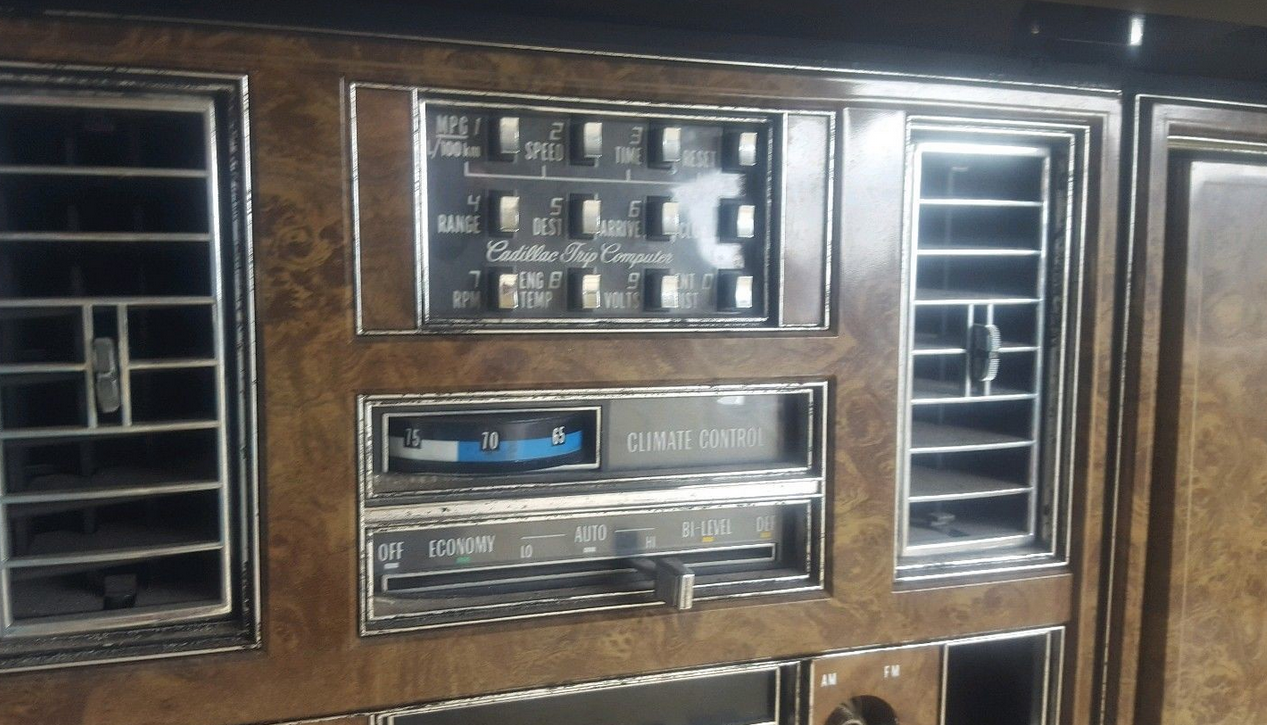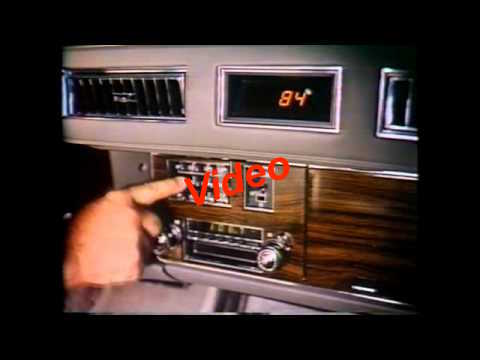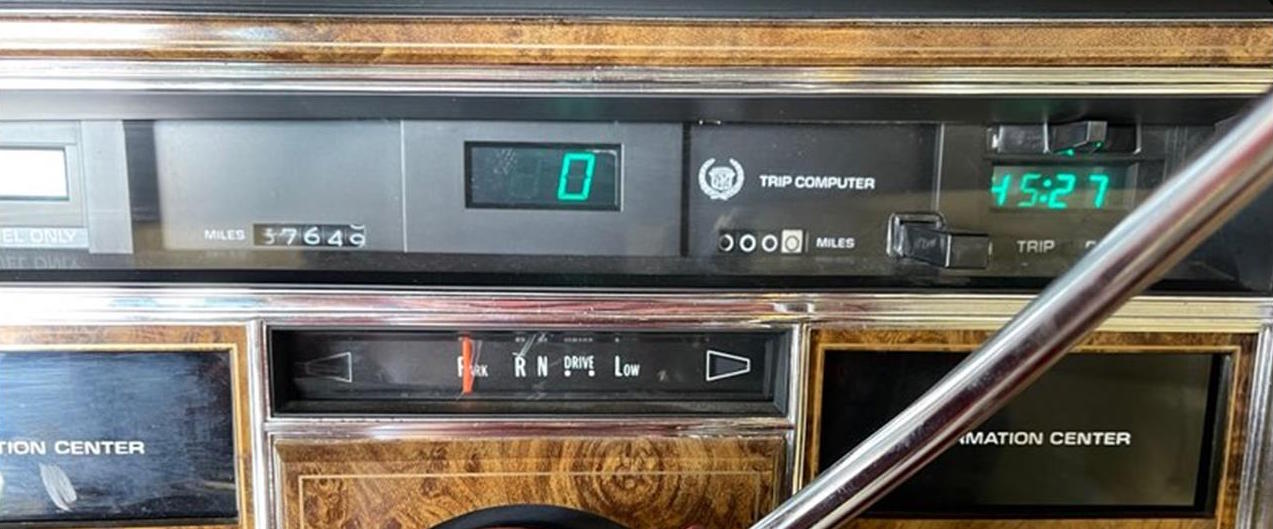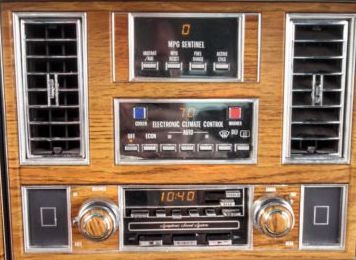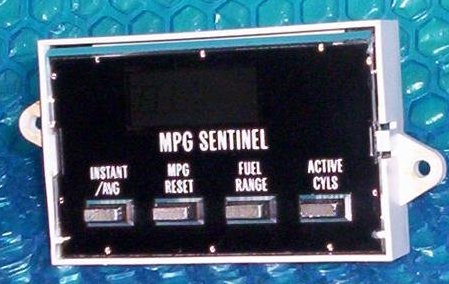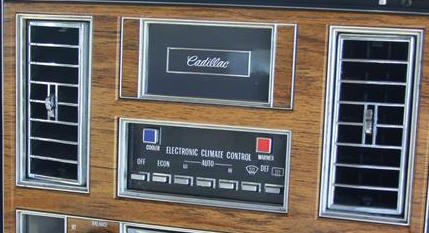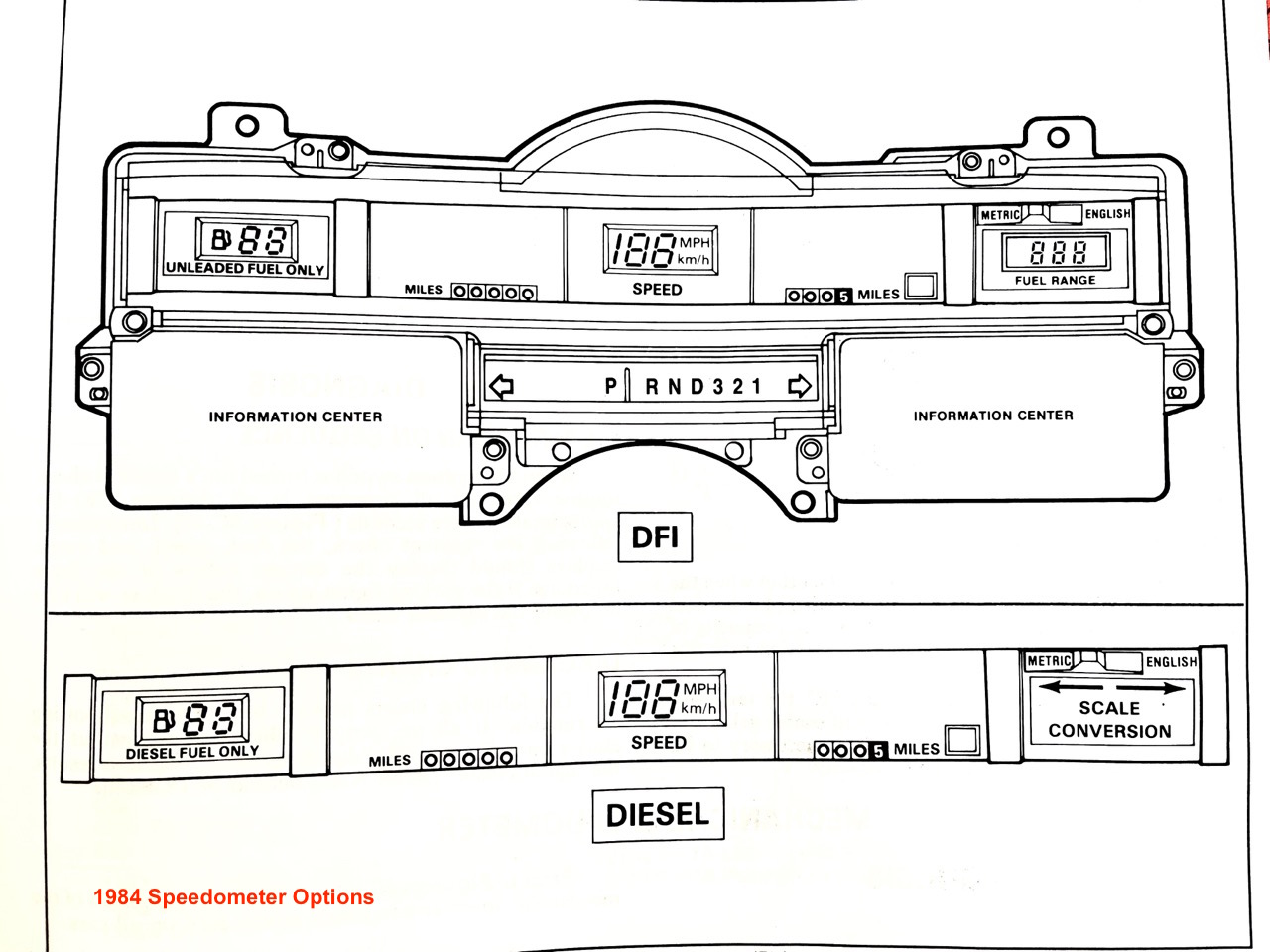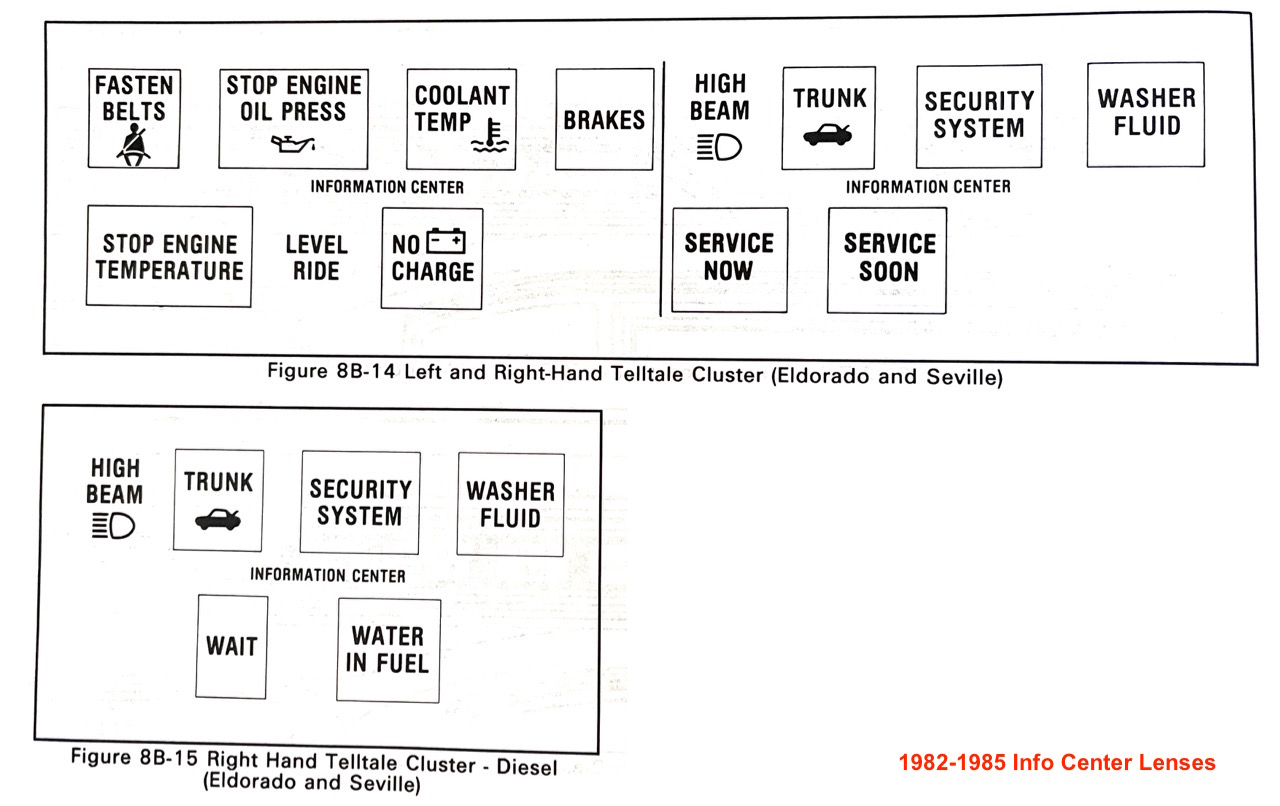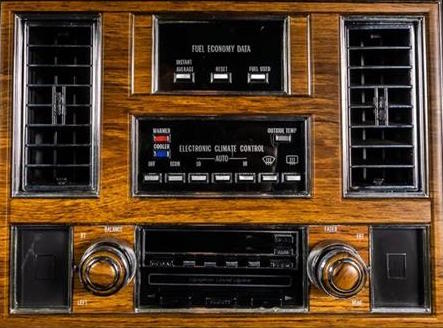|
1979-85 Eldorado Speedometer History
A brief history of Eldorado Speedometers, 1979-85
Hang on to your hats, this is exciting.....
Click Here: For Digital-to-Analog Speedometer Swap Info
Click Here: For Sound System Options 1979-1985
Click Here: For Annual Changes (Styling, Options, Engineering)
Return to: Main Page
|
Before We Begin: This page is intended to cover the changes and options on the Eldorado instrument cluster, however it's worth mentioning the sister cars before we dive in. "High Tech" was the watchword of the day, and with microprocessors becoming increasingly powerful, and prices declining, automotive engineers were putting them to work in new and "exotic" ways.
Since each division still had some autonomy in design, Buick and Olds did their own thing. The Toro offered an additional gauge package on their analog cluster, but didn't debut a digital dash until the Calienté package in 1984. Despite the spartan look, it included a digital trip odometer, high res fuel gauge and coolant temp, digital speed as well as a unique readout that could be toggled for both Outdoor AND Indoor temps. It was also the only E-body and only dash option that featured a 6-digit odometer. Note, no economy or mileage data was presented as these cars were either carb'd or diesel.
Buick, on the other hand, offered a digital dash from 1979 through 1985, and for '79/80, had a unique Trip Monitor option that accompanied the digital speedometer. Similar to the '79 Eldo Tripmaster, the rightmost display was repurposed after this option was dropped. For 81+ it became a trip odometer. Again, being carbureted, no instant or avg fuel data is available. Turbo Cars did have "Turbo Power" indicators.
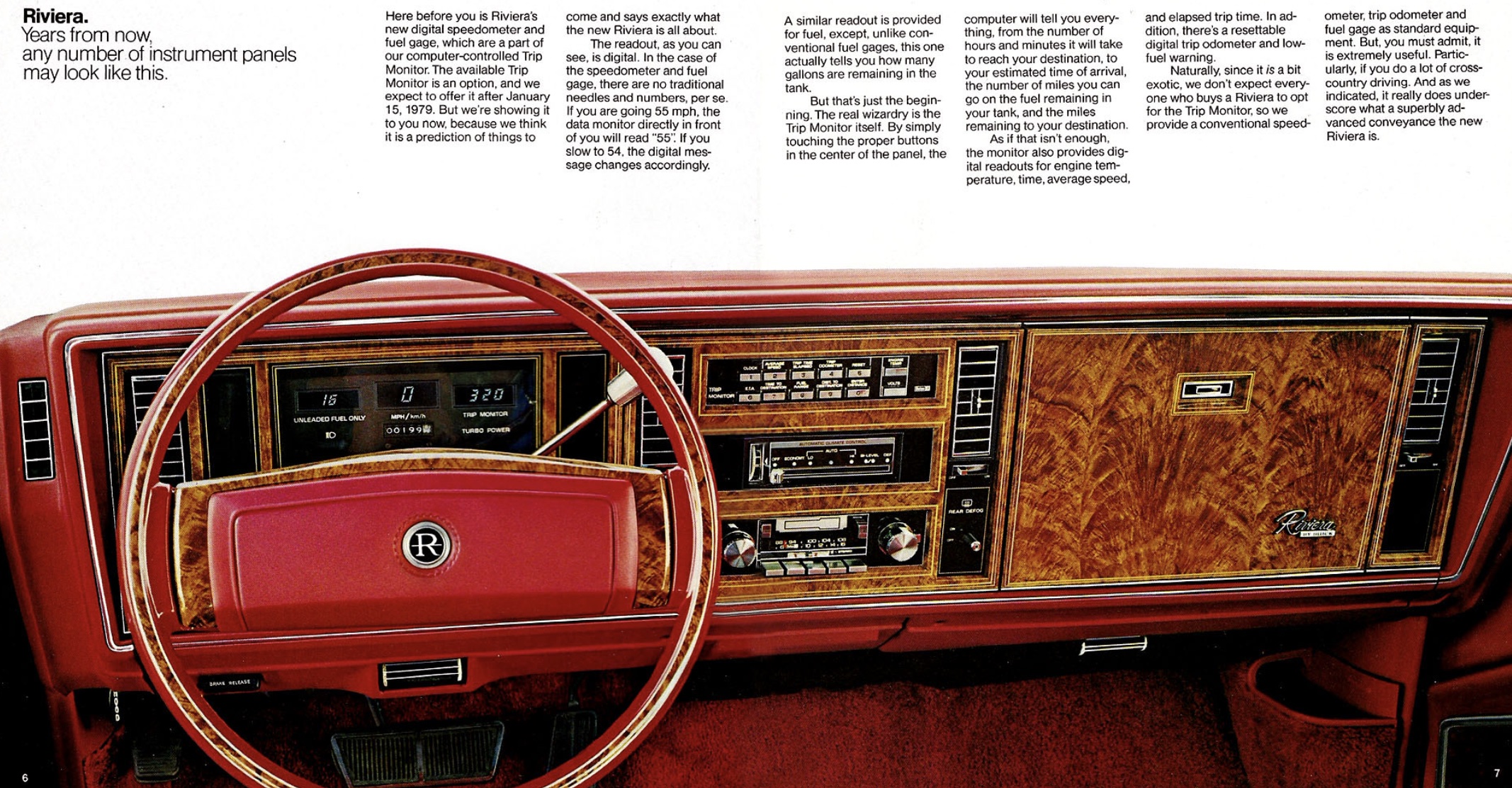
Riviera Trip Monitor option for 1979/80 - Click to Enlarge |
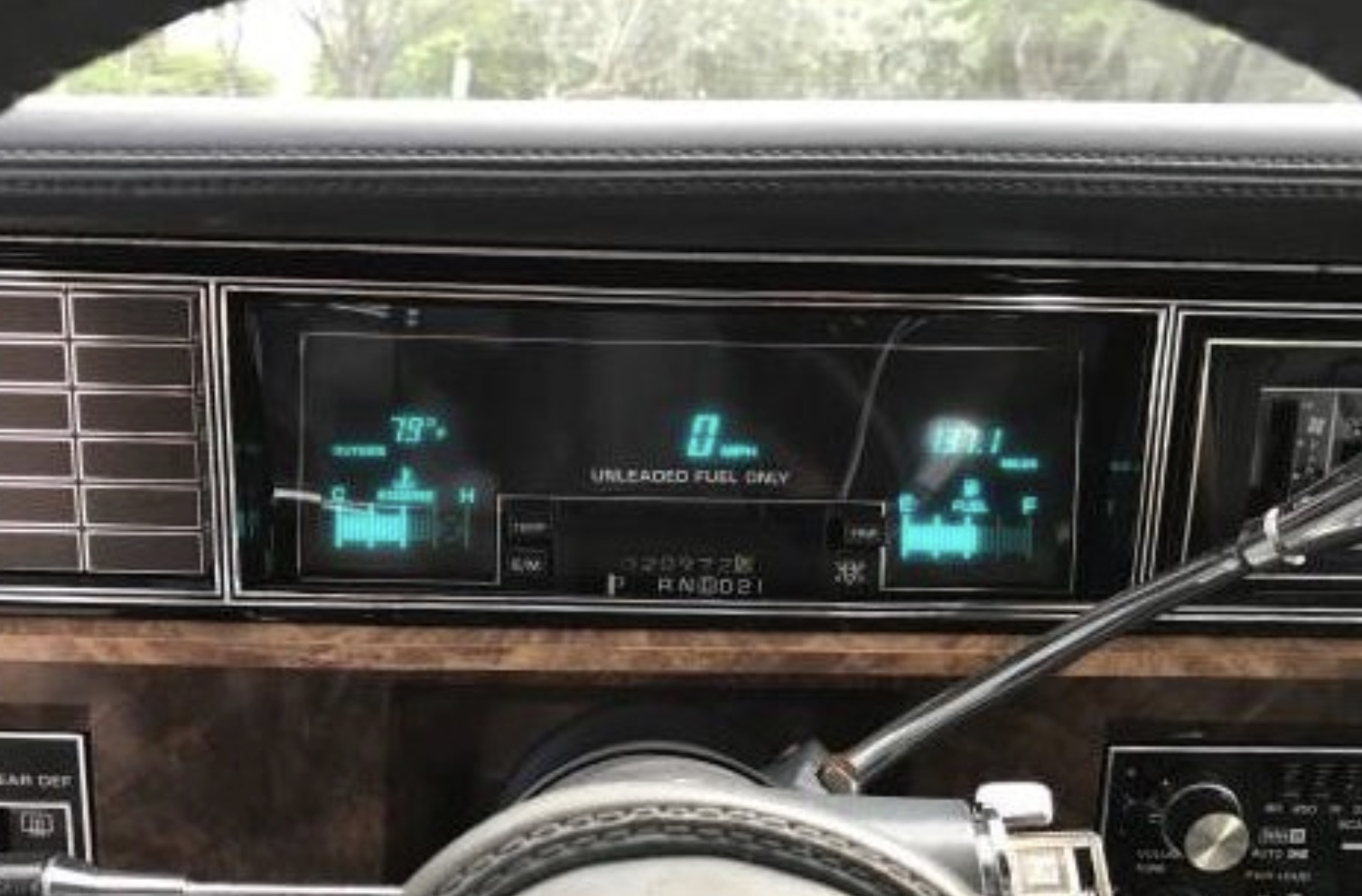
Toronado Calienté for 1984/85 - Note 6-digit odometer |
|
|
1979: The standard analog speedometer was a 1-year only design, featuring myriad hash marks on the speedo face and stubby turn signal indicators. There is no high-limiter peg for the speedo needle. The left 'Info Center' panel contains the old style amber & green lights for the UR3 Fuel Monitor option which are wired to a vac switch; while the right panel lacks any Service Soon/Now lights since the analog EFI did not have that feature. The exact same lenses were used even if you ordered a Diesel: Wait and Start were the only lights on the bottom row of the right lens. Of course, the fuel gauge legend read “Diesel Fuel Only”. Max speed indicated is 85 MPH. Note how narrow the displayed range is on the Fuel Gage; this was remedied in '80.
 |
You might be surprised to learn a 1-year only digital dash was available (EFI cars only). This was the 'Digital Tripmaster' U40 which populated the otherwise blank area over the Climate Control with a keypad that interfaced to a separate digital computer. At your fingertips were Engine Temp, Fuel Economy data, ETA, Range, Voltage, etc. This system was based on the 1978 Seville Trip Computer option, and takes input data from the Bendix analog EFI computer. For '79 it featured “16 improvements”, both to calculations as well as internal design. The major difference compared to Seville is how that data is displayed. On the Eldo, green vacuum fluorescent displays show Fuel Level, Speed, and on the right, the Trip Computer selected data. This was a rare and expensive option (confirmed $920 on Seville); not many were ordered and fewer survived. If you have one, be aware there were two different fuel pickups mated to this option depending if you had a CB-equipped Delco radio.
Incidentally, the Coolant Temp lights are amber on both analog and Trip Comp versions; these were changed to red later on. 1979 is also the only year for the analog climate control and a physical toggle switch for rear defrost.
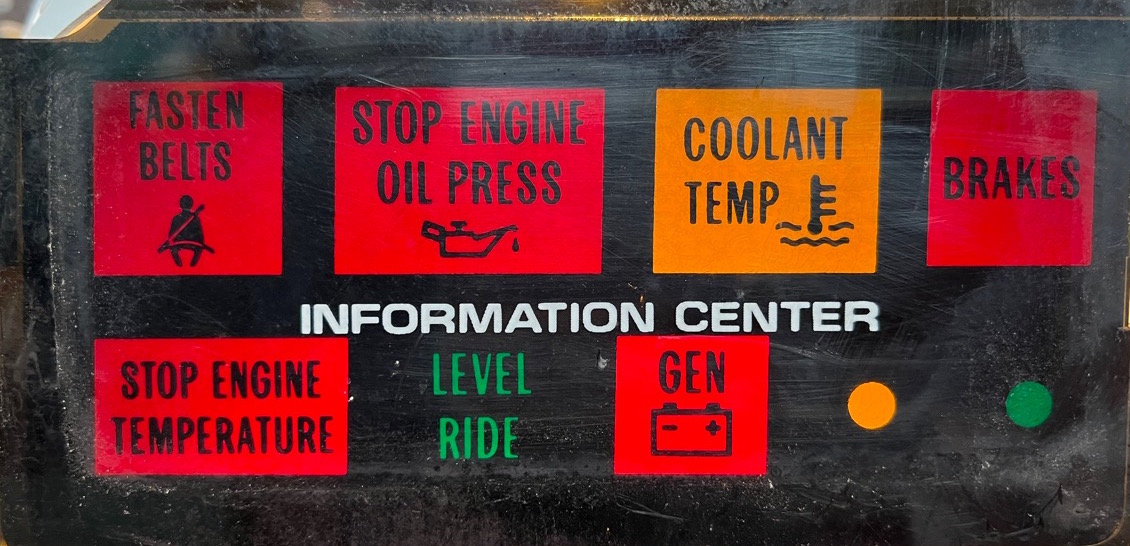
Left Info Center 1979 |
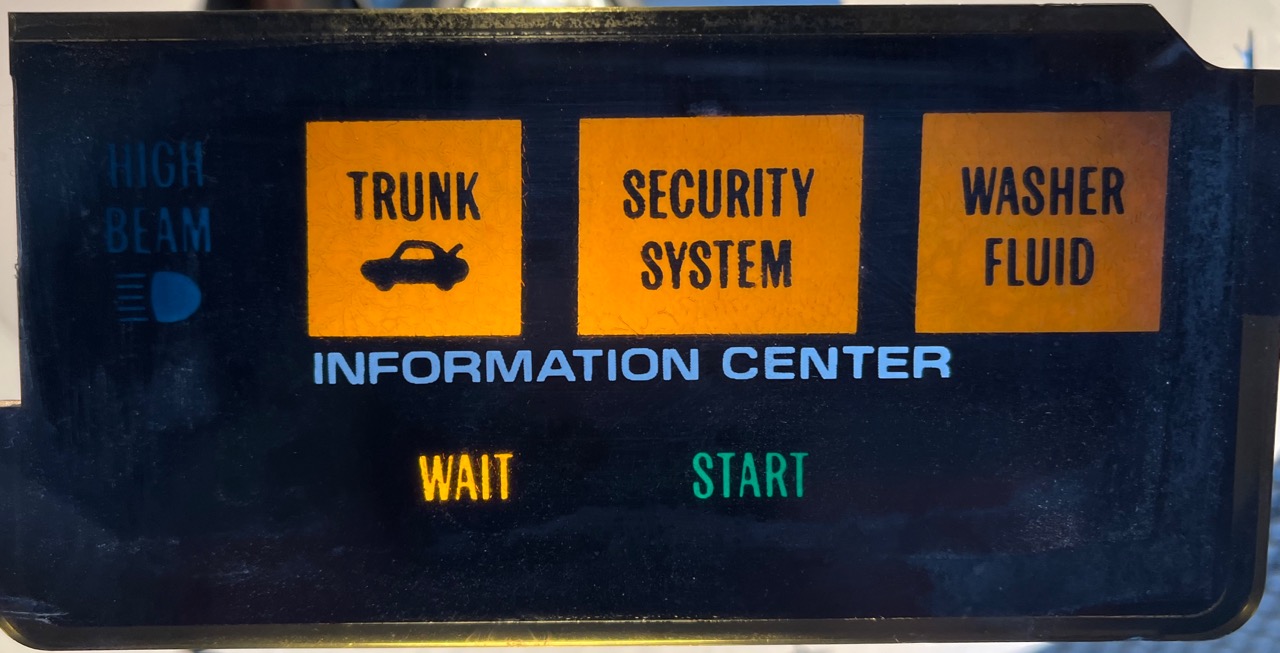
Right Info Center 1979 Filler Plate, '79-Only Analog ATC > |
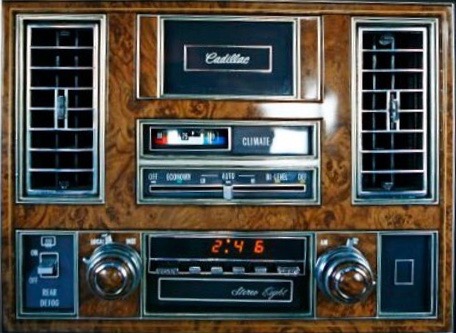 |
| In the “believe it or not” category, CA-spec cars used a modified EFI ECU that was closed-loop. The speedometer looks the same as a 49-state model until you hit 15k miles, at which point an EMISSIONS flag pops up to cover the odometer as a reminder to service the O2 sensor! ('80 CA-spec shown) Link to the Analog EFI Page |
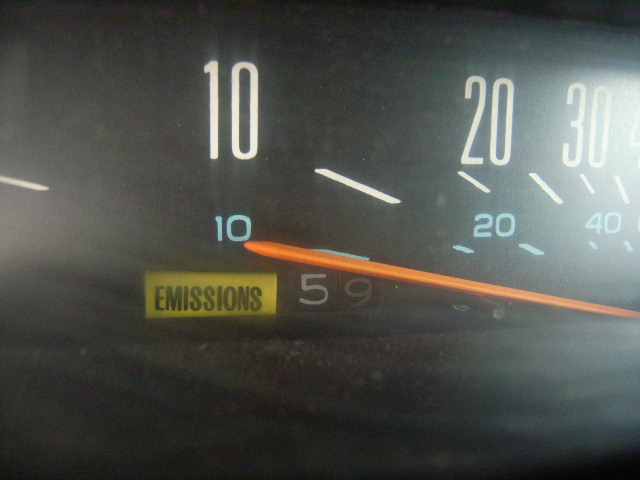 |
|
|
1980: The speedometer face was cleaned up by dropping the busy graduations, and E & F were pulled in on the fuel gauge to avoid misinterpretation. The turn signal arrows were revised and '55' called out, but the big news was the DEFI 368, which meant fuel economy data was standard on a new digital display above the (also new) digital climate control.
The “MPG Sentinel” display had 2 buttons...Average and Reset. Otherwise, it showed instant economy. The climate control panel allowed real time diagnostics and trouble code display from the ECM. The right side Info Center panel was revised to include a “Check Engine” light; a “Water in Fuel” light replaces the old “Start” light when equipped with a diesel. The left panel remained the same. The UR3 Fuel Monitor option was dropped from sales lit as the new MPG Sentinel makes it redundant, but there's a twist. For 1980, the amber and green bulbs are shown to be driven by outputs from the ECU! An individual with an export model fitted bulbs to those two sockets and the feature came alive. No word yet if that trick works on the domestic models.
 |
For CA-emission cars, the closed-loop Olds 350/EFI replaced the 6.0L DEFI engine. Ordering that, or the diesel, meant getting a filler plate in place of the fuel data. No Tripmaster was offered. A couple interesting "1-year-only" observations about '80. No digital speedometer was available. And no fuel “Range” feature was provided in the MPG sentinel. The shop manual shows at least one photo of the MPG Sentinel with the legend "MILES PER GALLON". Who knows if that ever made early production? Note: Export models did not have MPG Sentinel, but instead, a filler plate.
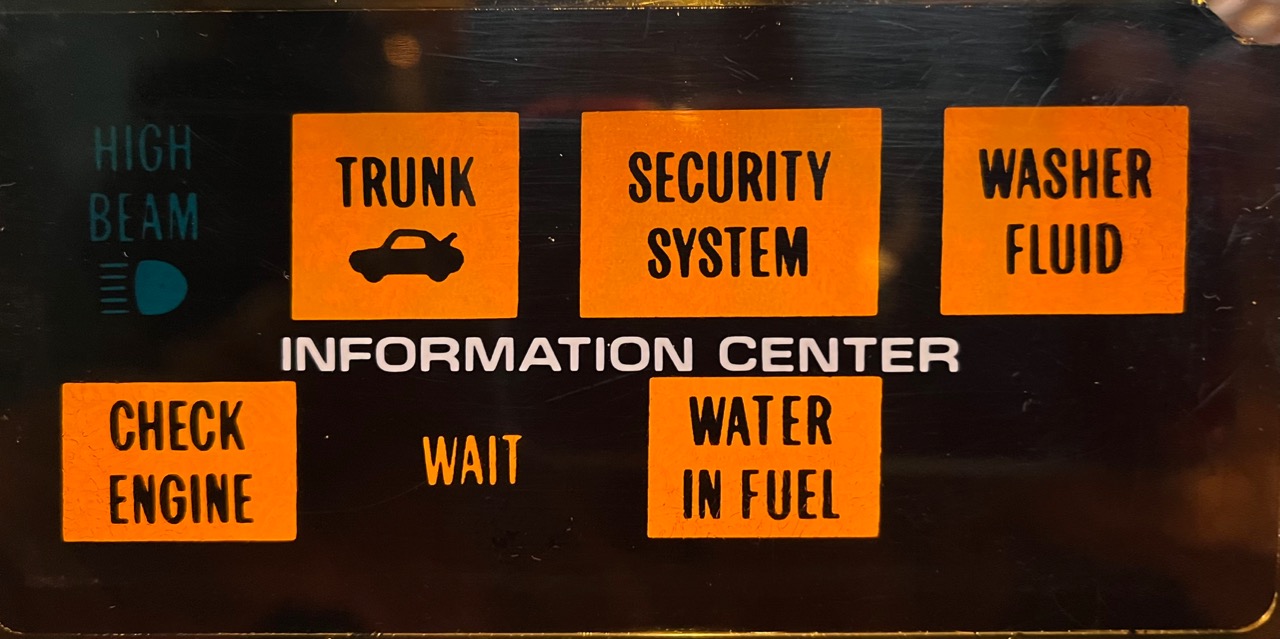
1980 Updated Right Info Center |
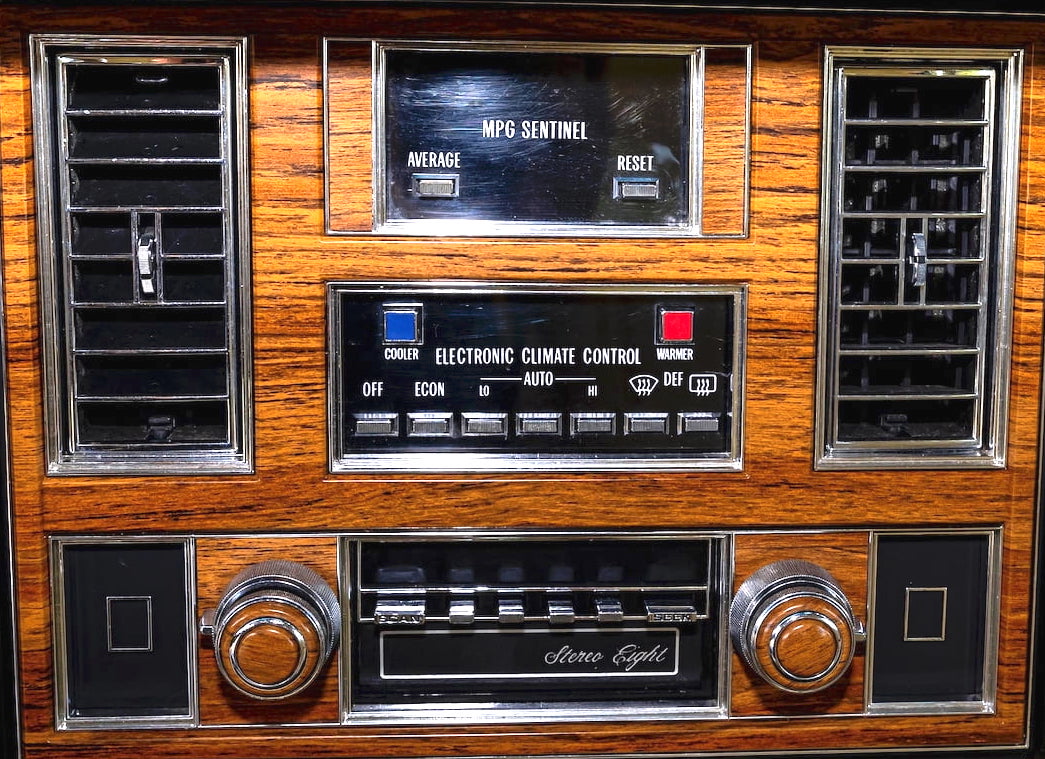 |
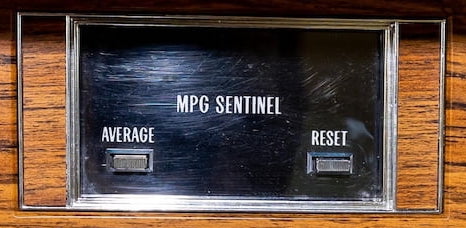
First year for DEFI MPG Display. Inst/Avg Only. |
Service Manuals tend to focus on repair and removal, so it was surprising to find the following in the '80 book. I rather doubt the validity of all of these....
"There are nine different instrument cluster assemblies available, listed below:" The manual then goes on to list...7 of them.
1. Domestic - Without fuel economy lights and low fuel indicator.
2. Domestic - With fuel economy lights and low fuel indicator.
3. Canadian - With fuel economy lights and low fuel indicator.
4. Export - With fuel economy lights and low fuel indicator (I'm sensing a trend...)
5. Diesel Domestic - With low fuel indicator only.
6. Diesel Export - With low fuel indicator only.
7. Diesel Canadian - With low fuel indicator only.
But Wait! There's more..... All 1980 368 DEFI cars also get a pop-up emissions flag like the CA-Spec 350. Except it presents itself every 30k miles as a reminder to have the catalyst in the converter changed out. Yes, I'm sure that was effective.
|
|
1981: New this year was the V864 variable displacement 368 engine. The analog speedometer appears unchanged, but a new digital speedometer (UO2) is offered, which looks very similar to the '79 Tripmaster speedo head, excluding the data selection shaft. In fact, it looks the same as the 82-85 p/n, but the pinout is completely different despite using the same connector. It's also worth noting that some of these '81 digital speedometers have “MPH/km*h” printed under the digital readout. I suspect these are very early cars as the sales material shows the usual “SPEED”, instead.
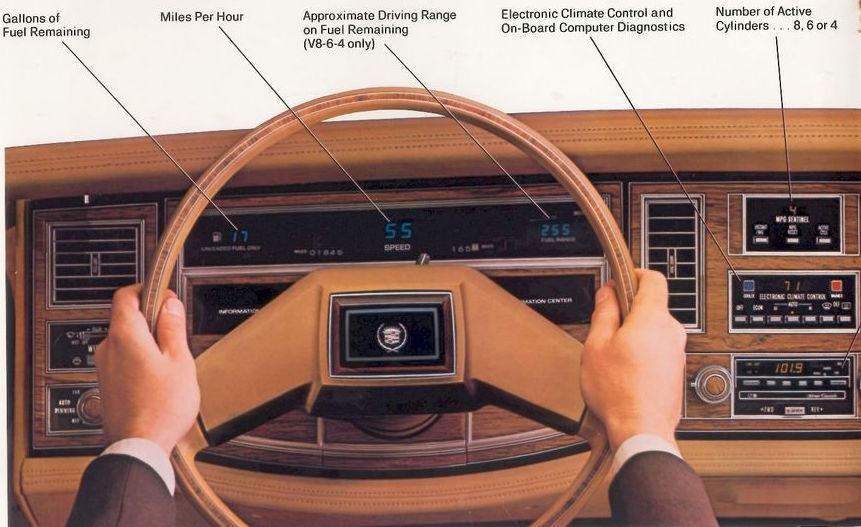 |
< Note 3-button MPG Sentinel when Digital Speedometer is ordered.
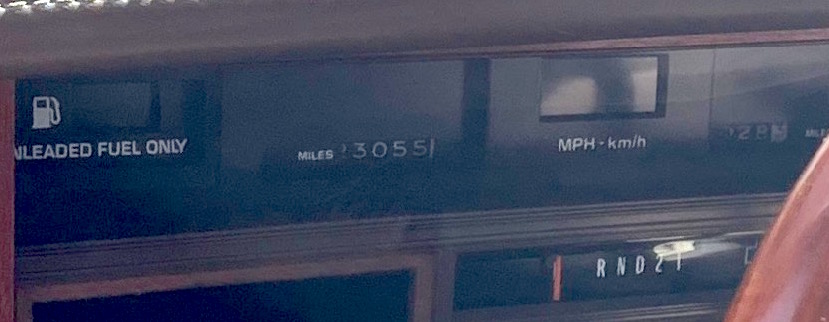
Photo I snapped of a 1981 Pierre Cardin Evolution 1 with MPH-km/h legend.
At least one Cad dealer film shows this as well.
|
“Fuel Range” is now offered; on the digital speedo it's calculated in, and displayed, on the right of the speedometer head itself. If you order analog, it's a display option on the center MPG Sentinel. Interestingly, on analog cars that range calculation is performed by a separate (1-year only) computer module that sits in the data stream between the ECM and the Climate Head, and reads fuel level as well as a couple other inputs.
The “MPG Sentinel” panel was updated to allow viewing of the 'Active Cylinders' for the V864 system. If you ordered the digital speedo, it was a 3 button unit. If you ordered the analog, a 4th button was added to provide the 'Range' feature mentioned above. Diesel, and the 4.1L V6 gas option, got you the old filler plate. Also note, there are no status indicators above the buttons on the MPG Sentinel. This would arrive later with the new Fuel Data panel.
Diesels: You could actually order the digital speedometer option on the diesel, but there was no Range Display since there was nothing to calculate fuel range from. Needless to say, most diesels that are still running around have analog speedometers. (Note: The line drawing below is from 82-85 due to PRNDL, otherwise same as 81 for all intents.)
Parts I pulled years ago suggest the left info center panel was changed in '81 to eliminate the green/amber lights, revising the BATT legend to NO CHARGE, and changing the Coolant Temp light from orange to red.
|
|
1982-1983: 1982 was the introduction of the HT4100 and 4-spd transmission. With it, the climate control and supporting electronics were also improved.
Click Here for the HT4100 Diagnostics Page
The speedometer face remains unchanged, though the PRNDL was updated to accommodate the new trans. The left Info Center panel was carried over. And whereas the right Info Center lens was previously shared between gas and diesel versions, the addition of a Service Soon Light (and revision of Check Engine to Service Now) necessitated a separate part number as they were out of space. I believe Diesels with their 'Wait' and 'WIF' lights carried over the old lens as the alternative option.

Note new 4-Speed PRNDL and blackout dash trim |
The “MPG Sentinel” display was renamed “Fuel Economy Data” and the CYLS button was dropped along with the variable displacement 368. The climate control head was changed to accommodate the addition of an Outside Temp button. The 2-shaft radio was carried over through '83.
Just as in 80/81, the climate control head drives the MPG Sentinel Display, only now it takes its range calculation from the ECM. On the 4100, the ECM data-stream also carries the Outside Temp value. However, a diesel still offers this feature, but the sensor is read directly, and the MPG Sentinel isn't available. Thus the Climate Control module part numbers differ between 4100 & V6/Diesel.
What was a standalone Range computer unit in 1981 was integrated into the ECM for the analog speedometer 4100 cars. If you ordered the digital speedo ($229 option in '82), the range calculation continued to be performed in the speedometer itself.
|
|
1984/1985
The speedometer head remained unchanged, but the new Delco 2000 radio options meant the center dash bezel had to be altered. To accommodate the new faceplate height, the vents were shortened (the entire inner dash structure changed), and the “Fuel Economy Data” display was widened to match the climate head width. With space at a premium, its name was shortened to “Fuel Data”. Other changes included deleting the plasti-chrome trim from the dashboard and vents in favor of a flat black monochrome look, and a headlight knob change to match the new radio. For a rundown of radio options '79-85, see the Sound System page.
Something else rather interesting...it's the 84/85 ECC Head but with a 'Fan' icon over the center button. Service Part? Very Late Production?
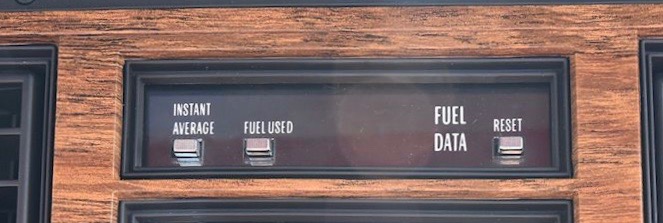
3-function Fuel Data display paired with digital speedometer |
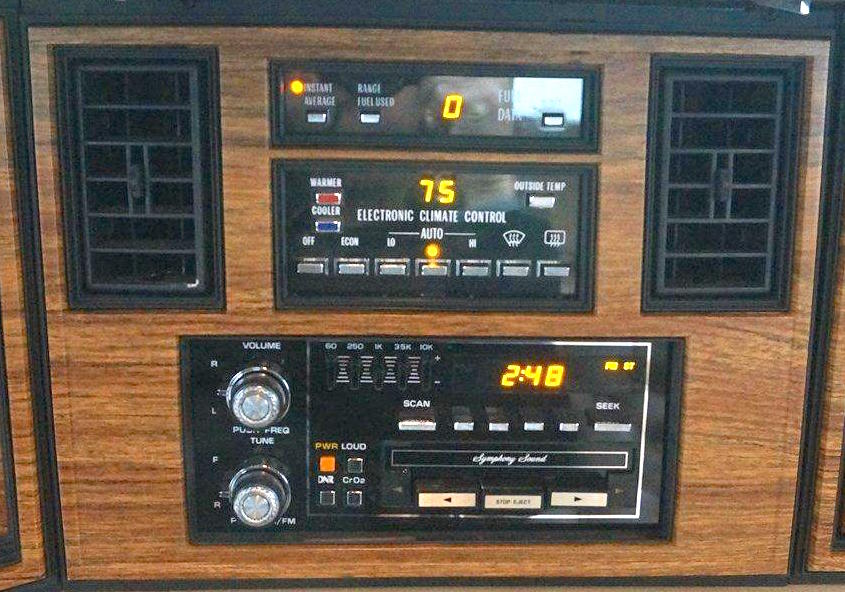
New Fuel Data form-factor with Delco 2000 radio |
|
|
Anomalies:
Cadillac offered an extensive list of export speedometers for the 79-85 E/K cars, including a version (84/85) that would sound an alarm if 120 km/h was exceeded.
This is apparently still law in the UAE, and was just recently adopted by India (5/22).
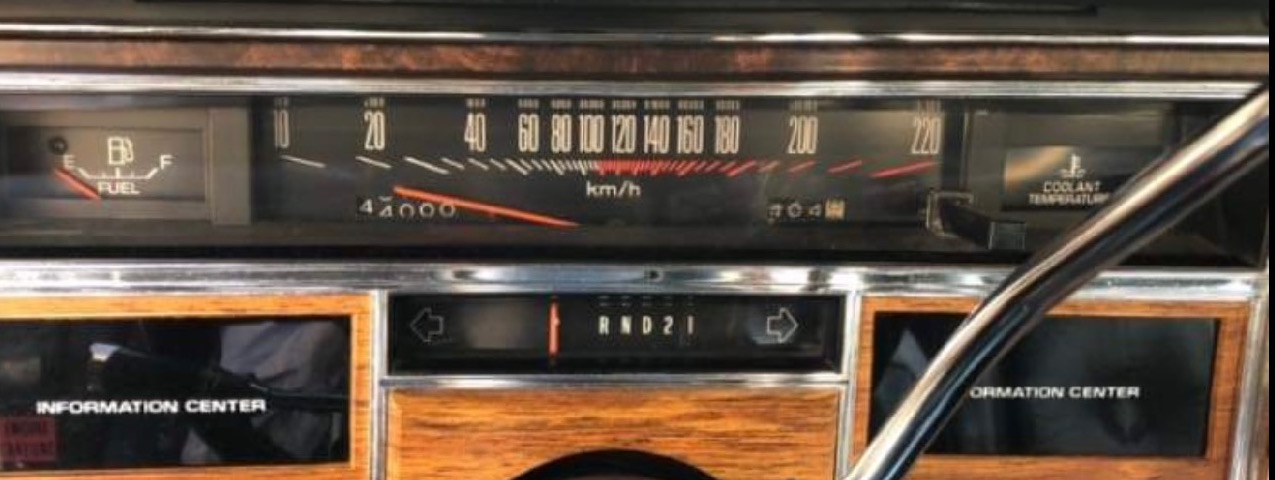
True export speedometer with a 220 km/h range. Note Fuel Gage legend. |
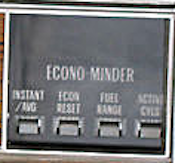
MPG SENTINEL doesn't really work when you measure fuel in liters. Behold, the ECONO-MINDER. |
Yet another version of the export 220 km/h speedometer on an '80/81.
|
 |

An example of a Canadian Export Speedometer, favoring km/h but still featuring MPH. |
Some intrepid individuals use these on US-spec cars with a different speedo-driven gear, resulting in a 140 MPH scale. |
| Here's the Diesel dash for 1979, including Fuel Gage and special badge over the steering column. Note the unique 3-position Cruise Control switch for '79. |
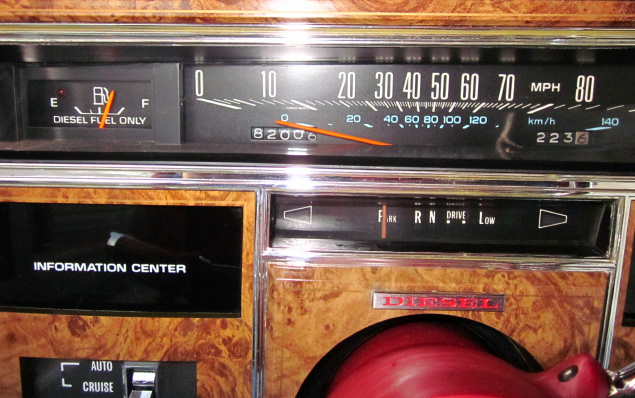 |
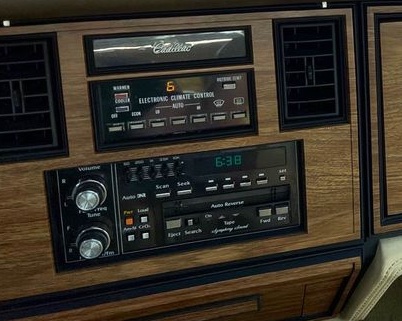 |
 |
The White Whale! It's taken a long time to find an example of the 1984/85 Diesel filler plate.
Wouldn't it be something if that actually lit up... |
Ever met anyone that actually used the parking brake? |
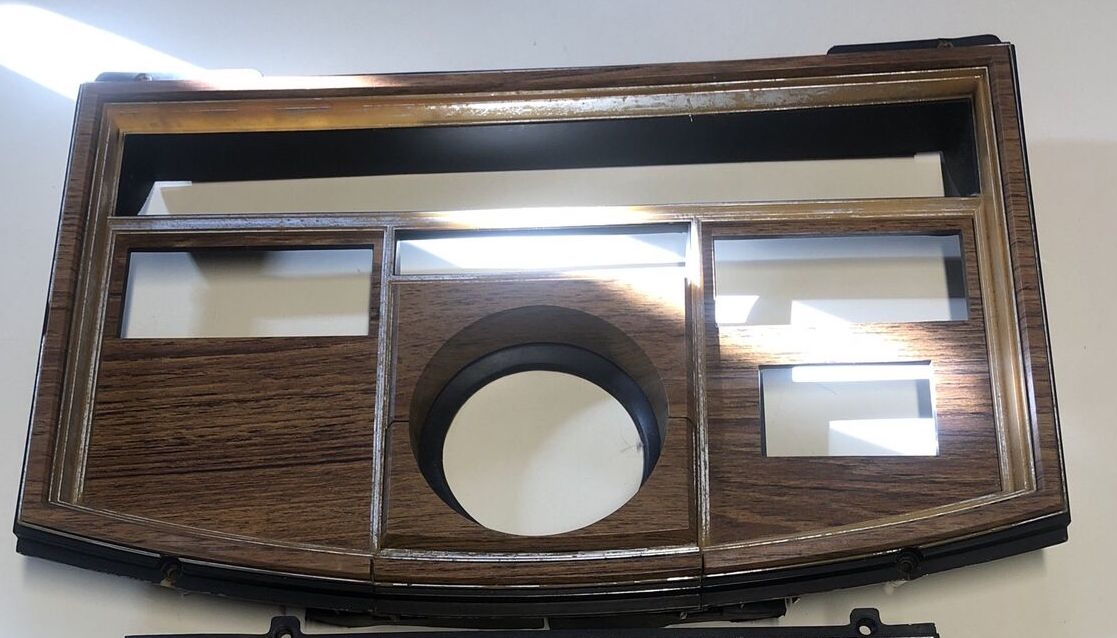
A real oddity! Yes, Cruise Control was still a $175 option on these cars, though almost always ordered. Here's an example of the dash trim if you didn't order it. |
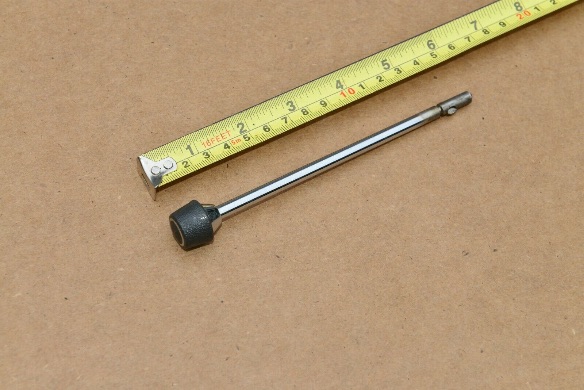
And the corresponding turn signal lever....
|
|
|
Parts Interchangeability:
Woodgrain aside, the center panel does interchange between Seville and Eldo, year-for-year. The panel around the speedometer will not as the Eldo dash has a curve below the steering column, while the Seville's is flat.
Can you swap an early 2-shaft radio panel and a late Delco 2000 radio (84/85) center panel? The answer is No. When the radios changed, so did the entire inner dashboard structure. This also goes for the MPG Data readouts as the mounting points and interior cavity are completely different.
While we're at it, the '79 panel is also unique due to its analog climate control and toggle switch rear defrost.
Electrically, the 82/83 square MPG Sentinel does interchange with the horizontal 84/85 module. Same pinouts, same features. But different mounting. '81 will not work due to V864 status.
For Climate Control (ECC Head) compatibility, see HERE.
Diesel and V6 cars share the same CC head p/n, and are incompatible with DEFI car CC heads. Most obviously, they lack the 2nd connector on the rear which carries a single circuit to the Fuel Data display. But more importantly, a number of inputs are different (no serial data, direct connection to outside temp sensor, etc.).
It's also worth mentioning that if you're replacing a failed unit, be careful what you buy. Eldos with rear defrost have an extra button on the panel for that feature, though it won't hurt anything if you swap a CC head in with that button, but lack a defroster. For an in-depth look at the DEFI relationship with these modules, Click Here.
|
Return to Main Page Comments? Corrections? Contact Webmaster Cory Heisterkamp 2022
|
|



